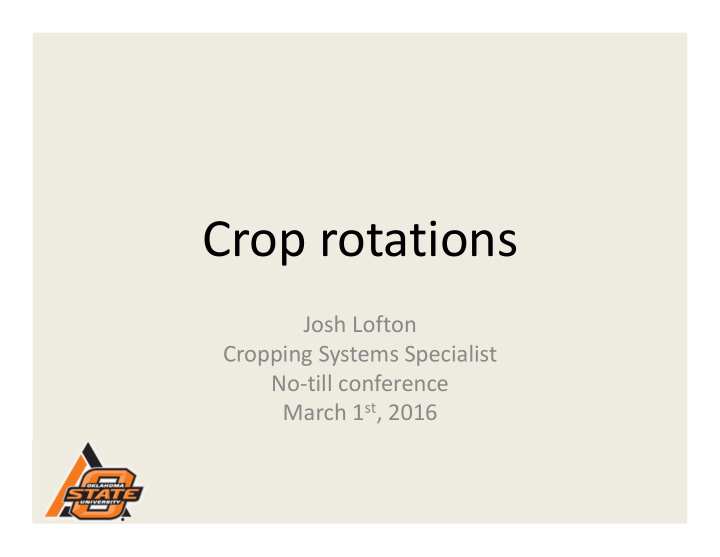



Crop rotations Josh Lofton Cropping Systems Specialist No ‐ till conference March 1 st , 2016
Why do we need to rotate? • Crops in Oklahoma (wheat, sorghum, cotton, soybeans) – We know how to grow it – Know how to make it profitable • Why change – “Inputs now, long term payback” – Benefits to the system • BMP • IPM – Yield/Profit • Wheat • Intense management = yield stagnation • Low input management = yield decline
Historic wheat yields • 1800 ‐ 1950s – 0.4 tons/ac • 1950s ‐ 1980s – 0.9 tons/ac – Semi ‐ dwarf varieties – Improved fertilization • 1980s ‐ current – Increased only 5.8 lbs/year in Great Plains – Oklahoma ‐ 1.0 lbs/year • We need to find ways to increase yields
Yield • Adding crop diversity has been shown to drastically increase yields • In Oklahoma – Adoption of canola in wheat production systems – 10 ‐ 20% increase in wheat yields – 20 ‐ 25% increase in wheat forage yields – Increase in net profit
Just in Oklahoma? • Seen in most production systems – Midwest • Corn and soybean – Southeast • Sugarcane and soybeans • Rice and soybeans – Southern US • Wheat and soybeans • Why yield benefits?
Rotational benefits • The benefits of rotations are basic – Monocot ‐ Dicot – Diversity in management/system • Breaks cycles • Allows for rotation of management practices • Spreads risk/labor – Diversity in crop profiles • Rooting profiles
Rotational benefits ‐ No till production • The benefits of rotations are basic – Monocot ‐ Dicot – Diversity in management/system • Breaks cycles • Allows for rotation of management practices • Spreads risk/labor – Diversity in crop profiles • Rooting profiles
Break in weed management cycles • Most important benefit in most systems • Allows for the rotation of chemistries – Wheat • Feral Rye, Italian Ryegrass, Wild Oats, Cheat – Soybeans/Cotton • Palmer, Waterhemp, Marestail, Ragweed • Conservation systems
Diversity in rooting profiles • Differences in rooting systems provide many benefits – Fibrous can be found deep in profile • More frail than tap roots • Need pores to travel • More roots per area – Tap roots • Continuous tap ‐ many shallower tap roots • True tap ‐ major deep tap root • Can be used to break through high density layers – Biotilling
Benefits of these varied rooting profiles • Root channels • Crop systems can be a drain on soil nutrients – Need more than typically “created” • Scavenging for nutrients in varied locations – Taproots have greater % of roots below 40” – Fibrous rooting systems mostly in top 24” • 65% of total – Taproots can scavenge deep nutrients and redistribute at or near surface
Understanding crop rotations • Numerous benefits exist for crop rotations – Yield – Management – Sustainability • Proper management is needed – Managing in ‐ season – Seasons down the road
Chemical restrictions • Mainly focused on herbicide – Applied to the previous crop – Burndown • Cut and dry? – Microbial – Soil pH – Soil texture – Temperature – Tillage? • Cover crops are part of the rotation as well
Allelopathy • Certain plants produce inhibitory chemicals to limit and stop the development and growth of another plant – Weeds impact on successive or in ‐ season crop • Ryegrass – Crops within a rotation • Autotoxicity • Corn ‐ Corn
Allelopathy ‐ Wheat ‐ Canola • Limited early season growth – Physical barrier? – Soil micro ‐ climate – Chemical restriction
Germinating biomass of canola treated with wheat residue 0.3 0.25 * 0.2 * Biomass (g) ** ** ** ** 0.15 ** ** ** 0.1 0.05 0 Courtesy of Dr. Angela Post
LCS – Mint Nontreated WB – Redhawk 7 DAT 7 DAT 7 DAT Courtesy of Dr. Angela Post
Rotations in Oklahoma • Benefits of rotations – More so in no ‐ till than conventional systems – Numerous – Yield – Economics • Remember what monocrop systems were previously • Crop management plan – Rotational restrictions of ag chemicals – Influence of previous crop • Crop rotational plan – Stick to the rotation not the markets – Inputs now for future benefits
Questions Josh Lofton Cropping System Specialist @OSU_oilseeds Josh.Lofton@okstate.edu
Recommend
More recommend